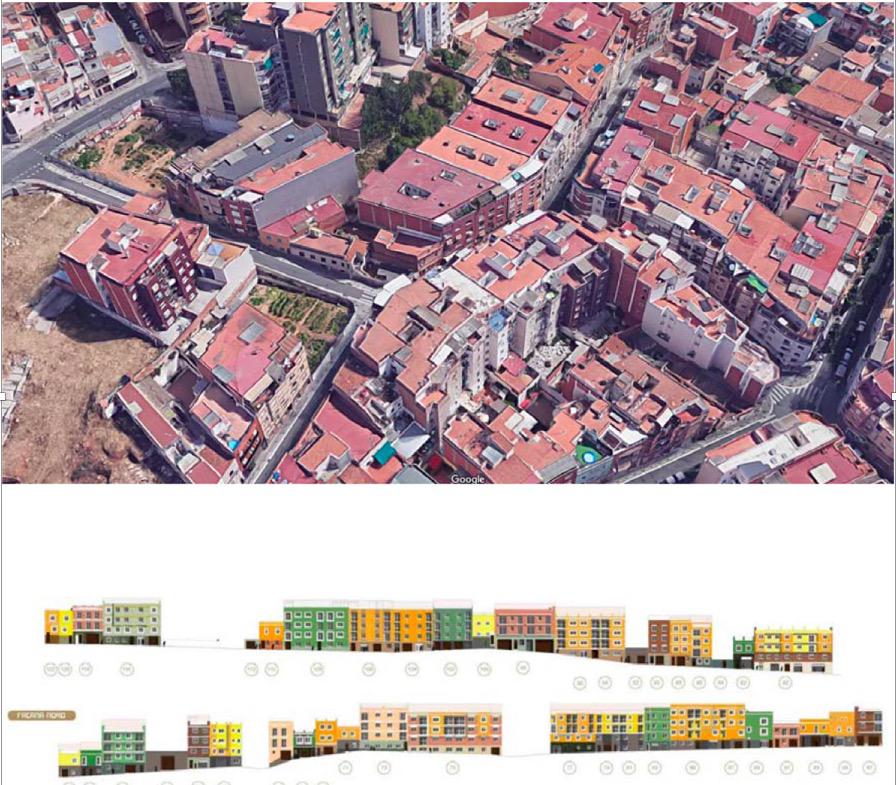INCENTIVES FOR REFURBISHMENT OF PRIVATE HOUSES IN PIRINEUS STREET, SANTA COLOMA DE GRAMANET, SPAIN

PROJECT DESCRIPTION
Pirineus street is located in Santa Coloma de Gramenet, a city on the left bank of Besos River. From 1955 to 1975 Santa Coloma’s population increased from 20,000 to 140,000 inhabitants. In those days the city grew without the social infrastructure and open spaces. Since 1975 these lacks are being tackled focusing on public facilities for example with projects like the Bru axis. However the new immigration wave from outside the EU, the construction boom and the subsequent financial crisis have hit strongly to this neighbourhood blocking the traditional regeneration tools on building renewal and increasing the neighbourhood decay. The area who’s density increased dramatically between 1955 and 1975 (from 20.000 to 140.000 inhabitants) is now facing several problems. Next to a lack of public space and public infrastructure, many buildings are in a bad state and need to be made more sustainable. The ownership is fragmented, since all the houses are privately owned. Previous attempts by the municipality for collective renovations were blocked by individual owners who were not willing to pay their share.
Activating & mainstreaming
To unblock this situation and help the private property regenerate themselves, the council combined two laws and designed a clear legal framework for the project.
- Defining a regeneration area on the Pirineus Street using the right to housing act. The main implications are: Owners must do the improvements the administration requires If they don’t do it they could even lose their property.
- Use of the law (3R act) which implies a mechanism that planning uses for new developments.
Financing
The law makes it possible to define an area in which the burdens and benifits are shared proportionally to their own % of ownership. The main implications are: Owners must pay the proportional part of the cost of the refurbishment. The property is the warrantee of the payment (access to the Housing Property Register). The administration can make pressure to the private to recover the money. With this legal framework the council has done a feasible refurbishment project for every block discussed and negotiated with the owners through a clear bottom up approach. Depending on the type of tenure, the owners have different possibilities to pay the refurbishment: Owners who let the flat have to pay everything at the beginning. Empty flats owned by banks or investors have to pay everything at the beginning. Owners who live there have three possibilities to pay: (1) Pay everything at the beginning, (2) Pay the debt monthly, (3) Don’t pay it, and annotate the debt in the Housing Property Register.
LESSONS LEARNED / RESULTS
Cities can both help and force private owners to improve the sustainability and condition of their property. In the end this is a political decision.
Compared to a more traditional Barcelona approach where existing buildings are demolished and replaced with more square meters to finance everything, the process in Pirineus street takes longer, is far more complex and uncertain and financially less profitable for the municipality. On the other hand the traditional approach no longer works here due to financial crisis and the fact that housing prices went down, so the municipality is forced to investigate new ways. This new approach is less traumatic in the sense that existing buildings are preserved and improved, the community is better engaged and other problems such as speculative subletting, the needs of the elderly, lack of financial means of owners are better detected and addressed.
DATA
City information
Population size: 101-250 thPopulation development dynamics within the city administrative limits (at the time of the project): Stable
Population development dynamics of the functional urban area (at the time of the project): No data/not applicable
Website of the city: https://www.gramenet.cat/
Project information
Project territorial scale:
NeighbourhoodProject geographical area: Transitional area
Project/building proportions: No data/not applicable; Project Area: No data/not applicable
Project main actors: City Government; Owners; 0
Project dominant property ownership: Private
Project development stage (at the time of description): No data/not applicable
Project duration: 2 to 5 years
Project starting date: 2015-2018



